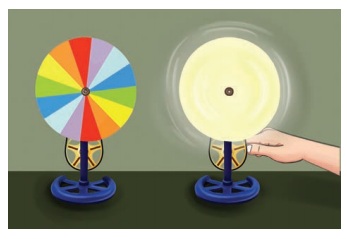Dispersion of Light
Subject: Science

Overview
The dispersion of light through a prism breaks into seven colors: red, orange, yellow, green, blue, indigo, and violet. The speed of electromagnetic waves in various media is what causes these colors, which have different wavelengths. Red light is the longest wavelength and fastest, while violet rays deviate more and fall to the bottom. Newton's disk is a disc created by proportionately painting each of the seven light-colored components, while a rainbow forms when the sun hides behind airborne water droplets. The rainbow appears semicircular when viewed from the ground but a circle when viewed from above.
Figures illustrate two different types of light sources: a blue light source and a yellow light source. We see the color white, not the individual colors, even though every day is a blend of red, orange, yellow, green, blue, indigo, and violet. Sunlight can be divided into these seven colors by passing it through a particular material.
Dispersion of Light Through a Prism
The dispersion of light is the process by which light that falls on the surface of a prism or other object with a comparable form breaks into seven colors while traveling through the object: red, orange, yellow, green, blue, indigo, and violet. These seven hues' waves have various wavelengths. The table below displays their values.
| Color of light | Limit of wavelength (in meters) |
| Red | From 6.2 × 10-7 to 7.8 × 10-7 |
| Orange | From 5.9 × 10-7 to 6.2 × 10-7 |
| Yellow | From 5.8 × 10-7 to 5.9 × 10-7 |
| Green | From 5.0 × 10-7 to 5.8 × 10-7 |
| Blue | From 4.6 × 10-7 to 5.0 × 10-7 |
| Indigo | From 4.4 × 10-7 to 4.6 × 10-7 |
| Violet | From 3.8 × 10-7 to 4.4 × 10-7 |
The visible spectrum is the band made up of the seven colors listed above in decreasing order of wavelength. "VIBGYOR" can be used to recall the visible spectrum's seven hues.
Cause of Dispersion of Light
All electromagnetic waves travel at the same speed in a vacuum, but they travel at various speeds in different mediums. The wavelength of a wave determines its speed in that particular medium. Within the visible spectrum, colors move at different speeds. Red light is the visible spectrum's longest wavelength light wave. It moves more quickly than other visible spectrum waves of different colors. Violet has the lowest wavelength and speed of all these seven hues.
Two refractions take place as light beams enter and leave a prism. Because of this, the light rays with various velocities that had split inside the prism come out of it by bending in the direction of the base and landing on the screen in various locations. Red light beams, which have the longest wavelength and the fastest speed in this process, deviate the least and are therefore visible near the top of the screen. Violet rays, on the other hand, deviate more than other rays and fall to the bottom of the screen since they have the shortest wavelength and the least speed.
Light as a Group of Seven Colors
Newton's disk is a disc created by proportionately painting each of the seven light-colored component colors on it. The disk appears white when spun quickly, as depicted in Figure, as the seven colors blend together.
Figure depicts two identical prisms, one of which is positioned next to the other upside down. The second prism recombines the seven hues of light beams that were split apart by the first prism as they go through it. The direction of the light entering through the first prism is parallel to the ray that emerges from the second prism.
Rainbow
A rainbow is a colorful, circular arc that forms in the sky when the sun hides behind airborne water droplets. The light is scattered by the water droplets hanging in the atmosphere, creating a rainbow. Water droplets act as a prism-like element in this process. 
The sun's ray of light enters the spherical water droplet after striking a point on its surface. Inside the droplet, the light rays split into seven different colors due to refraction. The droplet's opposite surface then completely internally reflects each of the droplet's seven colors of light. The figure shows that the violet light, which is the most deviated, is reflected from point C, while the red light, which is the least distorted, is reflected from point B. Ultimately, a rainbow is created as the light beams exit the droplet. When viewed from the ground, the rainbow appears to be semicircular, but when viewed from above, it looks to be a circle.
Things to remember
- The dispersion of light is the process by which light falls on the surface of a prism or other object and breaks into seven colors: red, orange, yellow, green, blue, indigo, and violet.
- The cause of the dispersion of light is the wavelength of a wave, which determines its speed in that particular medium.
- Red light beams have the longest wavelength and fastest speed, while violet rays deviate more than other rays and fall to the bottom of the screen.
- The Newton's disk is a disc that has each of the seven light-colored component colors painted on it in proportion, giving it the appearance of being white when spun quickly.
- A rainbow is a colorful, circular arc formed in the sky when the sun hides behind airborne water droplets.
© 2021 Saralmind. All Rights Reserved.




 Login with google
Login with google